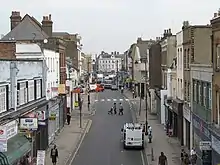Deptford High Street
Deptford High Street is a street in the Deptford area of the London Borough of Lewisham in south east London. It runs northwards from its southern junction with New Cross Road/Deptford Broadway (A2) for approximately 0.5 miles (0.8 km) to Evelyn Street/Creek Road (A200).

The northern half of the street passes under Deptford railway station, operated by Southeastern, on the North Kent Line. Opened in 1836, and situated upon the London Bridge – Greenwich Railway Viaduct, Deptford station is reputedly the oldest railway station in London.[1][2]
History
Previously called Butt Lane, it got its current name in 1825.[3]
When the social researcher Charles Booth visited the street in July 1899, it was considered the "Oxford Street of the South East of London". However, this comparison offered itself more with the section of the road south of the railway line, in which there are various shops and restaurants and in which a flea market takes place three times a week, than the quieter northern section.
At the end of the 19th / beginning of the 20th century, Deptford High Street was also shaped by German business people for decades. Booth has identified at least eight stores run by Germans, including a bakery, a butcher and a confectionery shop. With the outbreak of the First World War, anti-German sentiments affected the street. In October 1914, several German businesses were attacked, looted and set on fire and their owners were driven out. In the case of baker Goebel, not only was the bakery on the ground floor looted, but also his apartment above. An anti-German mob entered and threw everything out of the window onto the street, including a piano, bed, bedding, tables, chairs, porcelain and clocks.[4]
Until the 1960s, the area was mainly populated by the white working class.[5] Towards the end of the 20th century, the street changed again as a result of migration.
Murder
In March 1905, a shop at 34 Deptford High Street was the scene of a double murder, which led to the first murder trial in Britain where fingerprint evidence played a crucial part. Brothers Albert and Alfred Stratton killed Thomas and Anna Farrow, an elderly couple who tended George Chapman's oil and colour shop (today a newsagent) during a robbery. The Strattons were arrested, tried at the Old Bailey, found guilty, sentenced to death, and executed at Wandsworth Prison on 23 May 1905.[6]
The street today
As of 2020, there were only two pubs on Deptford High Street (The White Swan and The Jobcentre), where there used to be twelve. As of 2013, two former pubs were African restaurants, one pub had been converted into a nail salon, and another one was a youth centre.[7]
Deptford Market is held every Wednesday, Friday and Saturday, centred in Deptford High Street, Douglas Way and Giffin Street. It has been considered as one of London's liveliest street markets;[8] in February 2005, the High Street was described as "the capital's most diverse and vibrant high street" by Yellow Pages business directory, using a unique mathematical formula.[9] In 2018, Time Out described the street:
- "Over a quarter of a mile, it packs in a street market, a golden-clad library, one of London’s finest baroque churches, lots of Vietnamese restaurants and more history than you can shake a stick at."[10]
The street has two purpose-built churches: the Anglican St Paul's, Deptford (described as one of London's finest Baroque parish churches in the Buildings of England series)[11] and the Catholic Church of Our Lady of The Assumption, at 131 Deptford High Street.[12] The street's final bank was set to close in early 2021.[13]
References
- "Old Deptford History: Deptford Station". Archived from the original on 25 March 2012. Retrieved 19 June 2011.
- Staines, David (November 2011). "Deptford reborn". Modern Railways. Ian Allan Publishing.
- Barker's chapel, Butt Lane, Deptford Archived 2017-06-02 at the Wayback Machine (englisch; Artikel vom 26. März 2009)
- Joseph Bullman, Neil Hegarty, Brian Hill: The Secret History of Our Streets – A Story of London, S. 115f
- Joseph Bullman, Neil Hegarty, Brian Hill: The Secret History of Our Streets – A Story of London, BBC Books, London 2013, S. 75ff. ISBN 978-1-84990-451-3
- "Fingerprint saw brothers hanged for brutal murders". London News Online. 14 August 2020. Archived from the original on 17 November 2020. Retrieved 9 November 2020.
- Joseph Bullman, Neil Hegarty, Brian Hill: The Secret History of Our Streets – A Story of London, S. 135
- "London's Best Markets - Time Out London". timeout.com. Archived from the original on 15 September 2008. Retrieved 16 August 2008.
- Yell Group, Deptford is Top of the Shops - New study reveals London’s hidden gems in the High Street Hit Parade, 23 February 2005.
- Waywell, Chris (19 March 2018). "15 reasons to visit Deptford High Street, SE8". Time Out. Archived from the original on 24 October 2020. Retrieved 9 November 2020.
- Bridget Cherry, Nikolaus Pevsner, London 2: South London 1983:403; listed as one of three of Thomas Archer's "most accomplished and characteristic works" by Howard Colvin, A Biographical Dictionary of British Architects 1600–1840, 3rd ed. 1995, s.v. "Archer, Thomas".
- "Our Lady of The Assumption, Deptford". Our Lady of The Assumption. Archived from the original on 29 October 2020. Retrieved 9 November 2020.
- O'Byrne Mulligan, Euan (15 October 2020). "Barclays closure to leave Deptford High Street without bank". News Shopper. Archived from the original on 9 November 2020. Retrieved 9 November 2020.